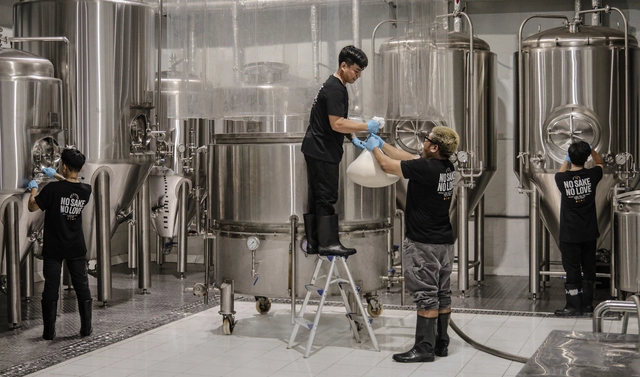
Sake is brewed at Mùa Craft Sake’s brewery in Ho Chi Minh City. Photo: Supplied
Our curiosity about Mùa Craft Sake began with the bold flavors of a sake-based cocktail introduced by chef Tru Lang, who proudly shared that it was brewed using Vietnamese rice.
The idea of brewing Japan’s national drink with Vietnamese rice, right in Vietnam, was intriguing enough to make us want to learn more about the story behind it.
On a scorching summer afternoon in Ho Chi Minh City, we visited Mùa Craft Sake in District 3 to chat with CEO Na Dai Kang and chef Tru Lang.
For first-time visitors to the place, the biggest surprise is likely the absence of hot sake—a concept familiar to many diners.
“When you first try cold sake in tropical weather like this, you’ll experience its refreshing, light, and really nice to have,” Na Dai said.
But that is just the beginning. A chilled sake glass opens the door to a completely unique sake experience at Mùa Craft Sake.
Freshly brewed sake in Vietnam? Why not?
The journey of brewing sake at Mùa Craft Sake began when Na Dai Kang found himself stuck at home during the COVID-19 pandemic.
Born and raised in Canada, Na Dai moved to Vietnam at 25, working across industries including media, entertainment, sports, and fashion.
When the pandemic put leagues and events to a halt, Na Dai took the time to look back at his path.
Conversations with friends in the F&B industry, especially those in craft beer, led him down an entirely new road.
The more he researched, the more he realized Vietnam's deep appreciation for Japanese cuisine and culture, evident in the growing number of Japanese restaurants across the country.
In 2022, Vietnam even ranked ninth among the world's largest importers of Japanese sake.
At the same time, the global trend of brewing craft sake outside Japan was also gaining traction, further fueling Na Dai’s idea of a local sake market.
After considering options such as importing sake from Japan or OEM, Na Dai and his team chose the hardest path: brewing sake in Vietnam themselves.
When Na Dai announced his plan, people called him crazy.
Brewing sake outside Japan was already a challenge, but doing so in Vietnam’s hot and humid climate seemed even more improbable.
Yet, he did it. Not only did he successfully brew sake in Vietnam, but he also built a brand using Vietnamese rice.
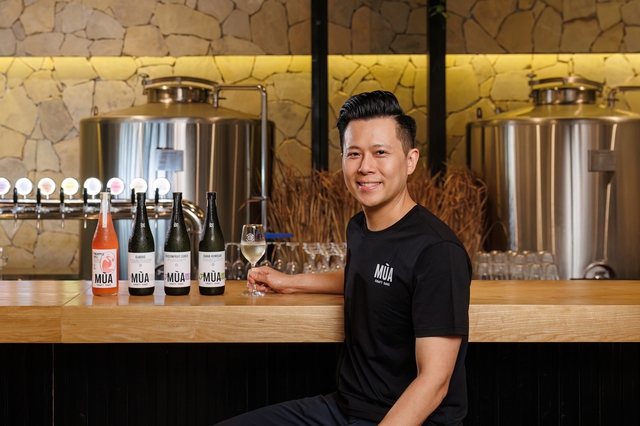
CEO Na Dai Kang pictured with various sake bottles at Mùa Craft Sake. Photo: Supplied
“The fascinating thing about sake worldwide is it always tells the story of a country’s take on what sake is supposed to be,” Na Dai said.
“Looking at other markets, they are able to utilize resources within that country, but also create a sake that fits to the palate of the locals. That made us ask what Vietnamese sake is, what it entails and looks like.”
Because the venture was so challenging, Na Dai faced numerous setbacks in securing partnerships and investments.
Finally, in 2022, Mùa Craft Sake was born through a collaboration between Japan's Heiwa Shuzo sake brewery, East West Brewing Co., and Mùa Trà Quế restaurant.
“Initially, we tried growing traditional Japanese sake rice, but we failed,” Na Dai recalled.
“So, we switched to finding Japanese rice varieties cultivated in Vietnam with similar properties.
“After analyzing about 20-30 strains, we identified one that worked and began production.
“After more than 100 trial batches, we reached the desired quality and started entering major competitions like IWC and the Tokyo Sake Challenge,” Na Dai shared.
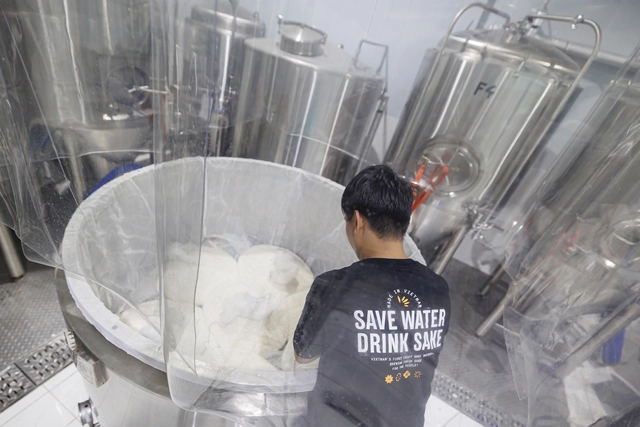
Ingredients are processed for brewing craft sake. Photo: Supplied
Brewing CT25 sake with ST25 rice
Successfully brewing sake in Vietnam was only half the dream.
After their initial success, they took an even bolder step: using Vietnamese rice to create what Na Dai proudly calls “Vietnamese sake.”
Mùa Craft Sake began experimenting with ST25 rice, which won the title of the world’s best rice in 2019 and 2023.
The result was CT25 sake—named after “Cò Trắng” (White Stork) to honor farmers, with “25” paying tribute to the rice variety.
Bringing CT25 to market was no easy feat also.
The team spent over a year and a half refining their process, ruining about 7-8 batches before achieving the desired quality.
The challenge lay in the complexity of sake brewing—each rice variety has unique characteristics, requiring precise adjustments in koji mold, yeast, acidity, and sweetness.
Moreover, ST25 rice carried the added responsibility of preserving its signature natural fragrance.
“It wasn't until our most recent batch that we achieved the quality we were aiming for, though we still need improvements to maintain consistency,” Na Dai noted.
On Mùa Craft Sake’s website, the pure rice version of CT25 is presented as the first ST25 sake, celebrating this renowned Vietnamese rice from Soc Trang.
“Due to its unique characteristics, the rice releases aromas of coconut, pineapple, and popcorn, with a dry finish,” the site said.
CT25 also comes in a pineapple chili variant, incorporating pineapple juice, chili, and hibiscus alongside the essential sake ingredients of rice, yeast, koji, and water.
According to Na Dai, ST25 sake is ideal for pairing menus at fine-dining establishments and is already being embraced by several restaurants.
The power of Vietnamese ingredients
Brewing sake was one thing; bringing it to customers was another challenge.
The founders realized that simply placing sake on retail shelves without a brand story wouldn’t be enough.
They decided to create an experience—a taproom where diners could “come for the food and stay for the sake.”
Chef Tru Lang was the perfect fit for this concept. As the founder of Mùa restaurant in Tra Que, Hoi An City in central Vietnam, he is committed to using only local ingredients—not just for sustainability but because he genuinely believes in the excellence of Vietnamese produce.
Mùa Craft Sake was born while staying true to Mùa's philosophy.
Of Chinese-Vietnamese heritage, Tru Lang received classically trained Italian and French cuisine and spent over a decade working in the U.S., Europe, and Japan.
When he returned to Vietnam in 2017, he noticed that local high-end restaurants at the time largely relied on imported ingredients as a way to signify quality, rather than showcasing local produce.
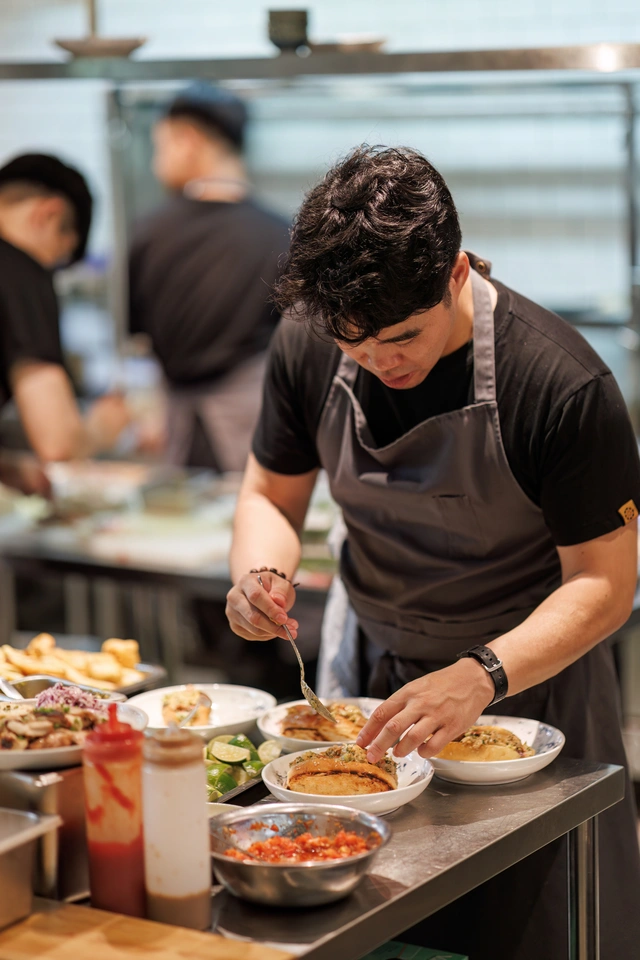
Chef Tru Lang prepares food to pair with sake. Photo: Supplied
He took the opposite approach, proving Vietnamese ingredients could shine. One of his successes was his take on beef tataki.
After a little research, he sourced tender veal from a farm in Cu Chi in outlying Ho Chi Minh City, surprising diners with its quality.
He also paired it with cham cheo, a northern mountainous spice, for a distinctive flavor.
Tru insisted that if they are brewing sake with Vietnamese rice, then the pairings should also highlight Vietnamese ingredients.
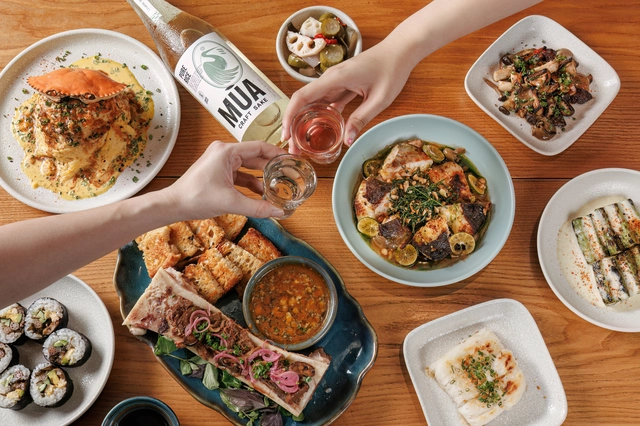
Craft sake brewed with Vietnamese ST25 rice is paired with dishes made from local ingredients at Mùa Craft Sake. Photo: Supplied
The pride diners feel when savoring high-quality local ingredients, as well as the satisfaction of a chef being able to tell guests, through taste alone, that “Vietnamese ingredients are exceptional” have driven Tru to tell even more stories about Vietnamese cuisine.
He aims not only to introduce it to the world but also to encourage young Vietnamese to better understand and appreciate their homeland’s culinary heritage.
“We were a bit ‘crazy’ with Mùa Craft Sake. We faced a lot of criticism, but I believe that if you really believe in something you just have to keep trying,” Tru shared.
The path was never straightforward, but after two and a half years, Tru, Na Dai, and their team take pride in what they have accomplished, knowing there is still much ahead to develop.
“Many people, especially the Japanese, are surprised when they taste our sake,” Na Dai said proudly.
If diners knew beforehand that it was made in Vietnam, they might be skeptical.
However, when served in a blind tasting—where diners sample four or five different sake types without knowing their origins—many choose the fresh namazake sake from Vietnam, he explained.
A sense of belonging
Chef Tru Lang still vividly remembers the moment he landed in Vietnam—the humid air instantly embraced him with an uncanny sense of familiarity, even though it was his first time setting foot in the country.
“This is where I belong,” he recalled thinking.
That feeling only grew stronger during his month-long journey exploring Vietnam from south to north.
The more he traveled, the more everything felt “right” to him—the air, the people, the rhythm of daily life.
This deep, natural connection ultimately led him to stay, and now, seven years later, Vietnam has become his home.
Kang Na Dai experienced a similar “strange” feeling when he visited Vietnam in 2005 to see his sister.
Born into a family of both Chinese and Vietnamese heritage, Na Dai grew up in Calgary with little exposure to the Vietnamese community beyond his family.
But that trip, taken at the age of 25, forged an intense connection to the people and culture of Vietnam.
What was meant to be a three-week visit left such a profound impact that, just three months later, he decided to move to Vietnam to live.
“In the blink of an eye, I’ve been here for 20 years,” Na Dai said.


Max: 1500 characters
There are no comments yet. Be the first to comment.